More than 80 homes are to be developed on the site of the former Notre Dame Convent at the foot of the Dumbarton Brucehill Cliffs.
West Dunbartonshire Council’s planning committee gave Miller Homes the green light to build 81 new homes despite concerns from campaign groups on the impact this would have on the environment and the species living there.
The houses will be made up of three, four and five bedroom semi-detached and detached houses on the land at Cardross Road.
READ MORE: Trees get special protection in Dumbarton woodland area
At the beginning of the month a Tree Preservation Order was approved following concerns that the proposals for the site would involve the removal of the trees.
The planning application was brought before members of the planning committee this morning.
Tom Cahill, technical director of the project, said: “Miller has been building houses across Scotland since 1934 with operations now covering most of the UK.
"We have a fairly large presence of homes in West Dunbartonshire - the first development we completed here in more than 20 years was at Queen Mary Avenue in Clydebank.
“The site has been identified for housing by the local housing development plan for 82 units and our final proposal is for 81 units. It is clear that the council consider this site appropriate for the development.
“The site will be accessed from Havoc Road with emergency access from Cardross Road which will feature collapsible bollards.
“The plans respond to topography, existing landscape features, the existing railway and the convent itself.”
During the meeting concerns were raised by objectors that this development would have a detrimental impact on the wildlife already living on the site while reducing air quality and increasing pollution.
They also claimed it could lead to the erosion of the cliff.
Questions were then asked about the SuDS (Sustainable Drainage Systems) which stop surface water flooding a construction site and whether or not this would see the removal of trees after all.
Councillor Karen Conaghan said: “I have a question with regards to the SuDS tanks and the proximity to the cliff edge.
“There were some trees there at the site visit which were indicated to be removed but those trees appear to be integral to the stability of the cliff.
“I want to make sure that by putting in a system that will remove water from the site, we are not causing another problem by removing the trees.”
Mr Cahill confirmed that there would not be any trees removed to facilitate the construction.
Councillor Conaghan added: “It is important that this new development allows access from the existing communities to the riverfront, to the woodland and the nature reserve as well as the new playpark.
“I am happy to support this development which addresses an area that has become overgrown, unsightly and subjected to anti social behaviour.”
Conditions were then put in place that will see the creation of a biodiversity action plan which will include species protection plans and implemented by the local authority.
Councillors then agreed to grant planning permission.







